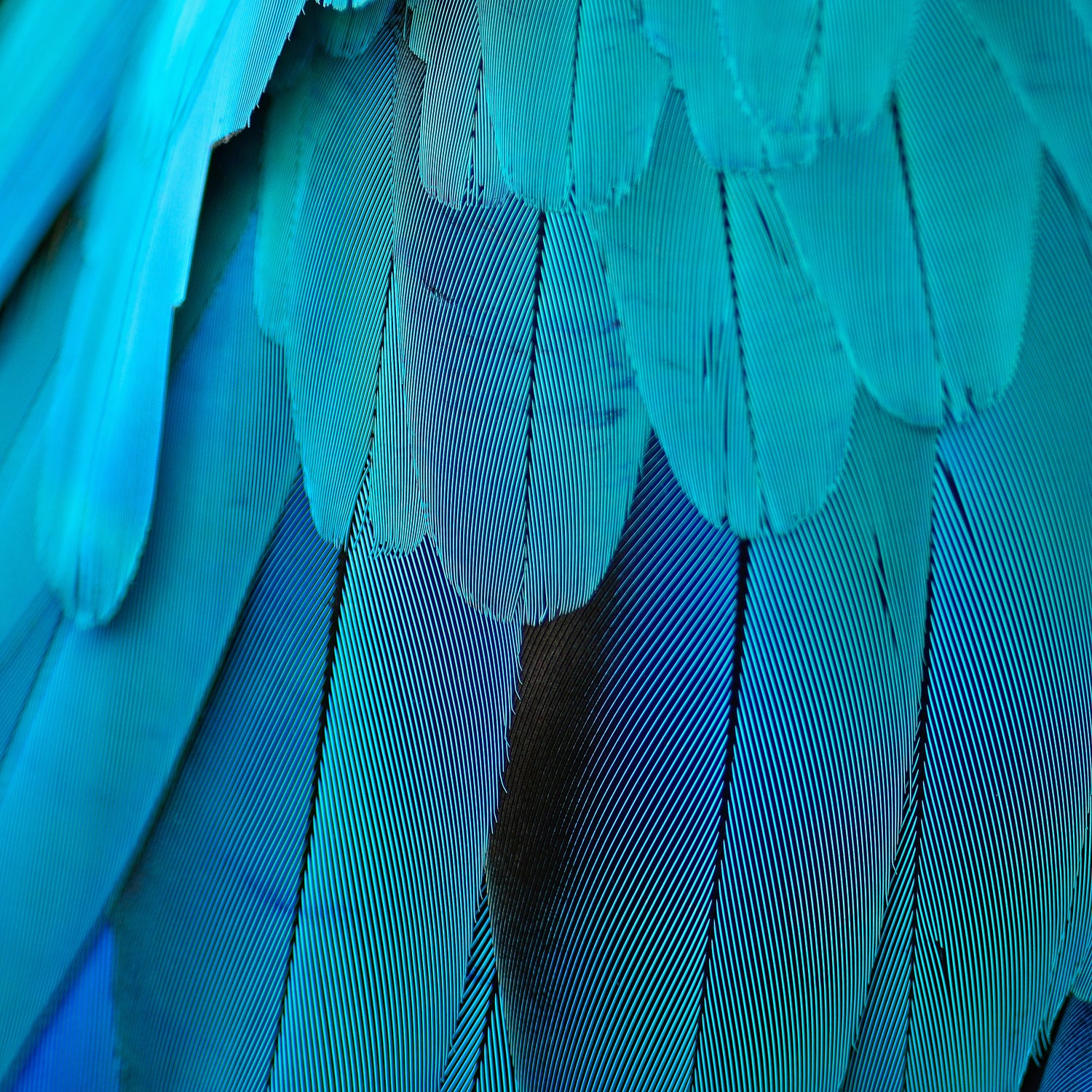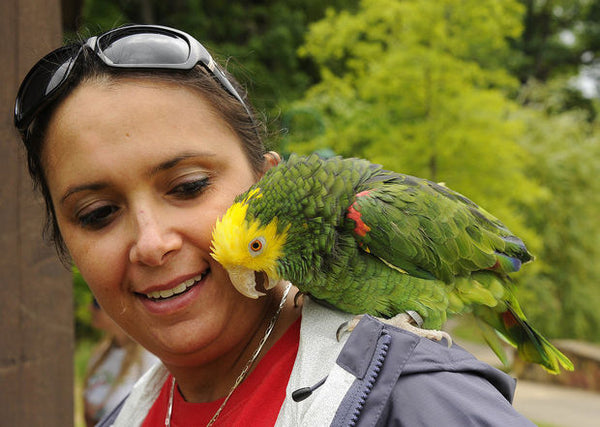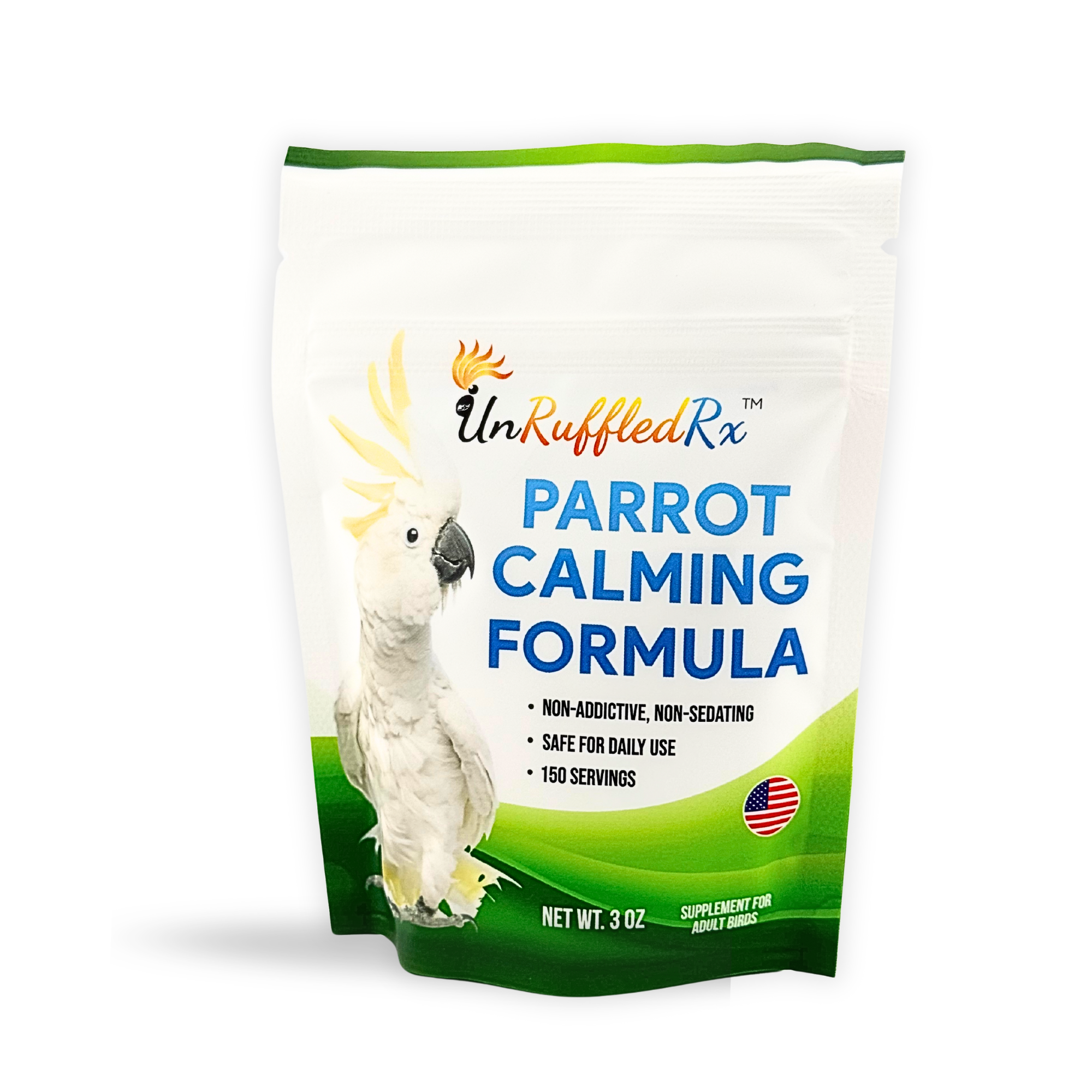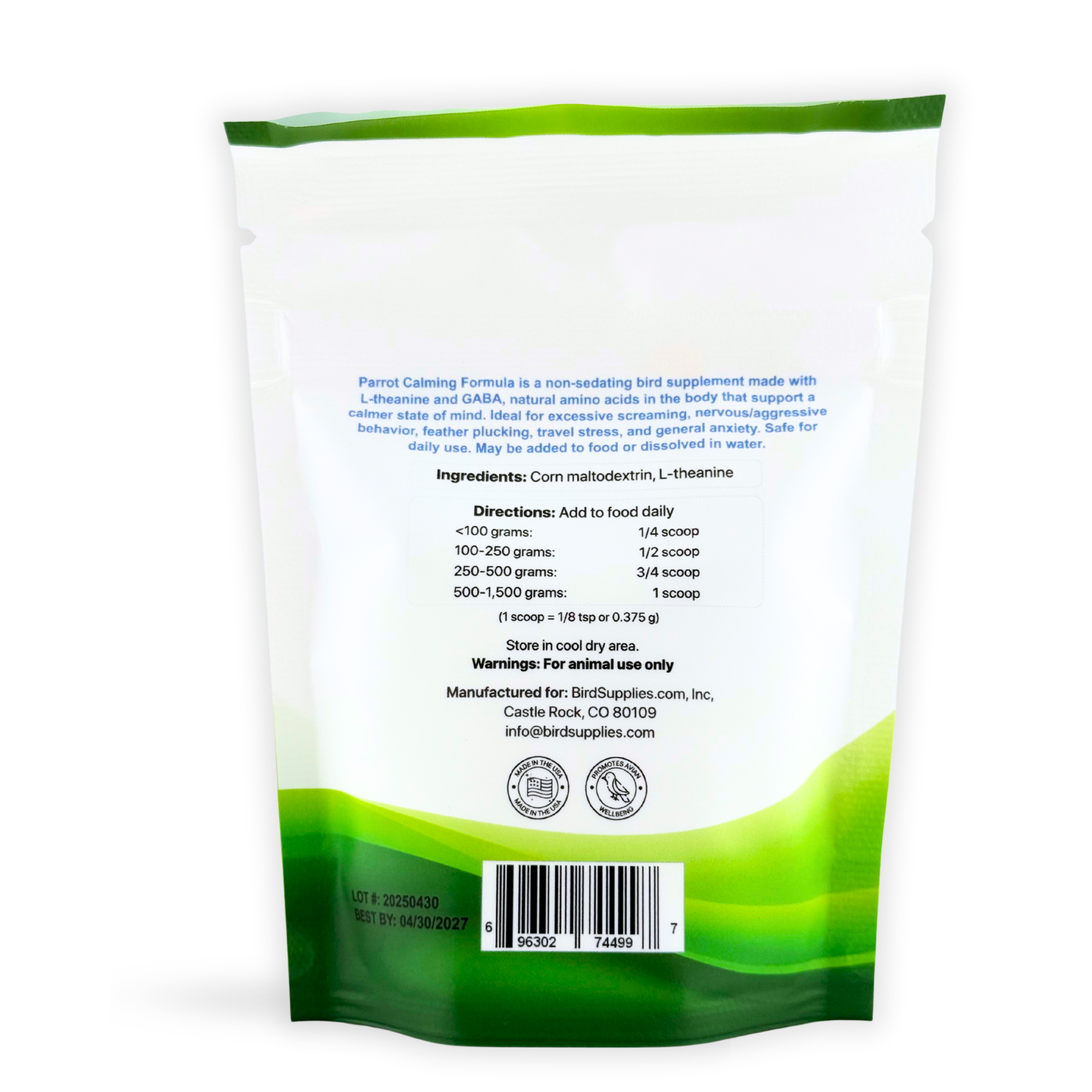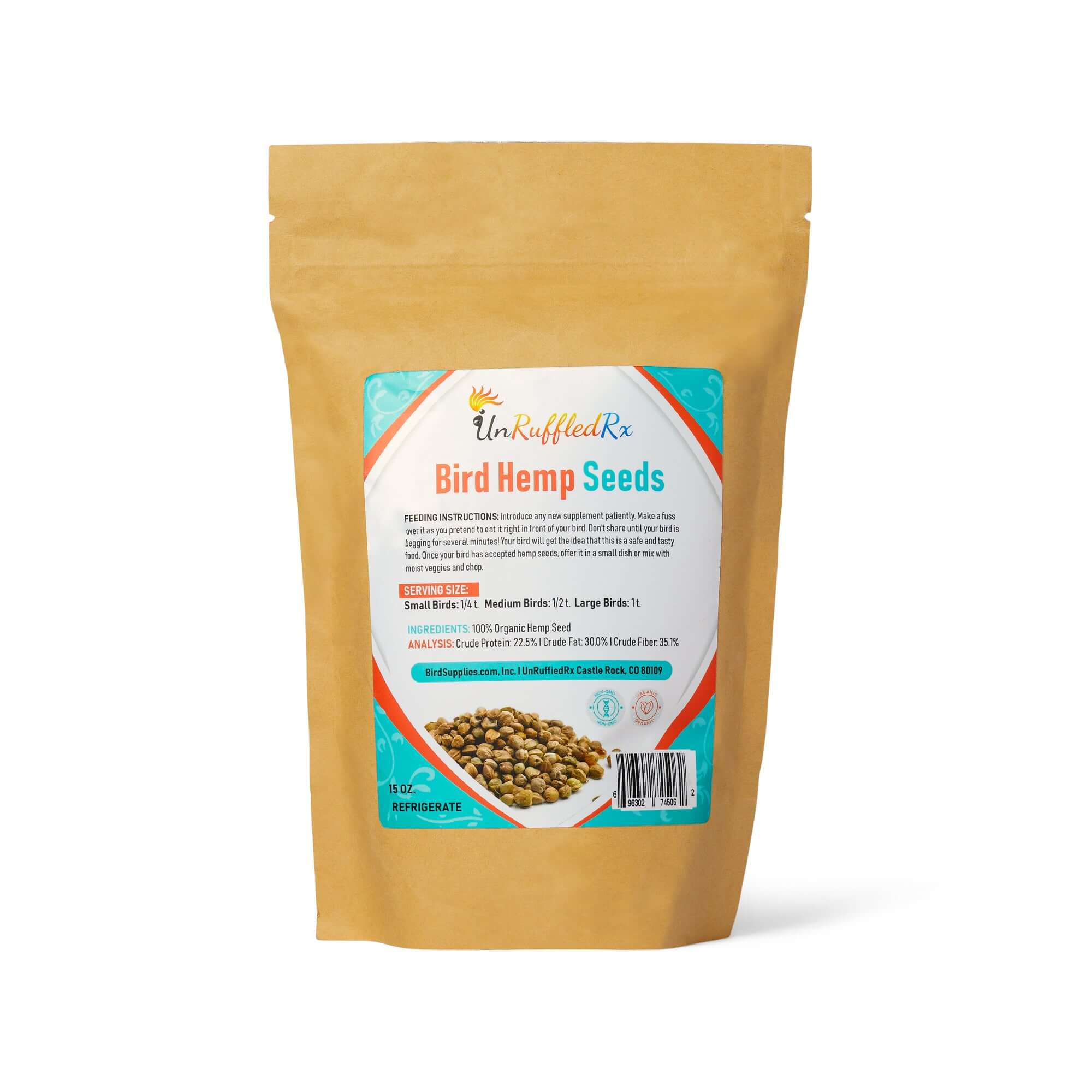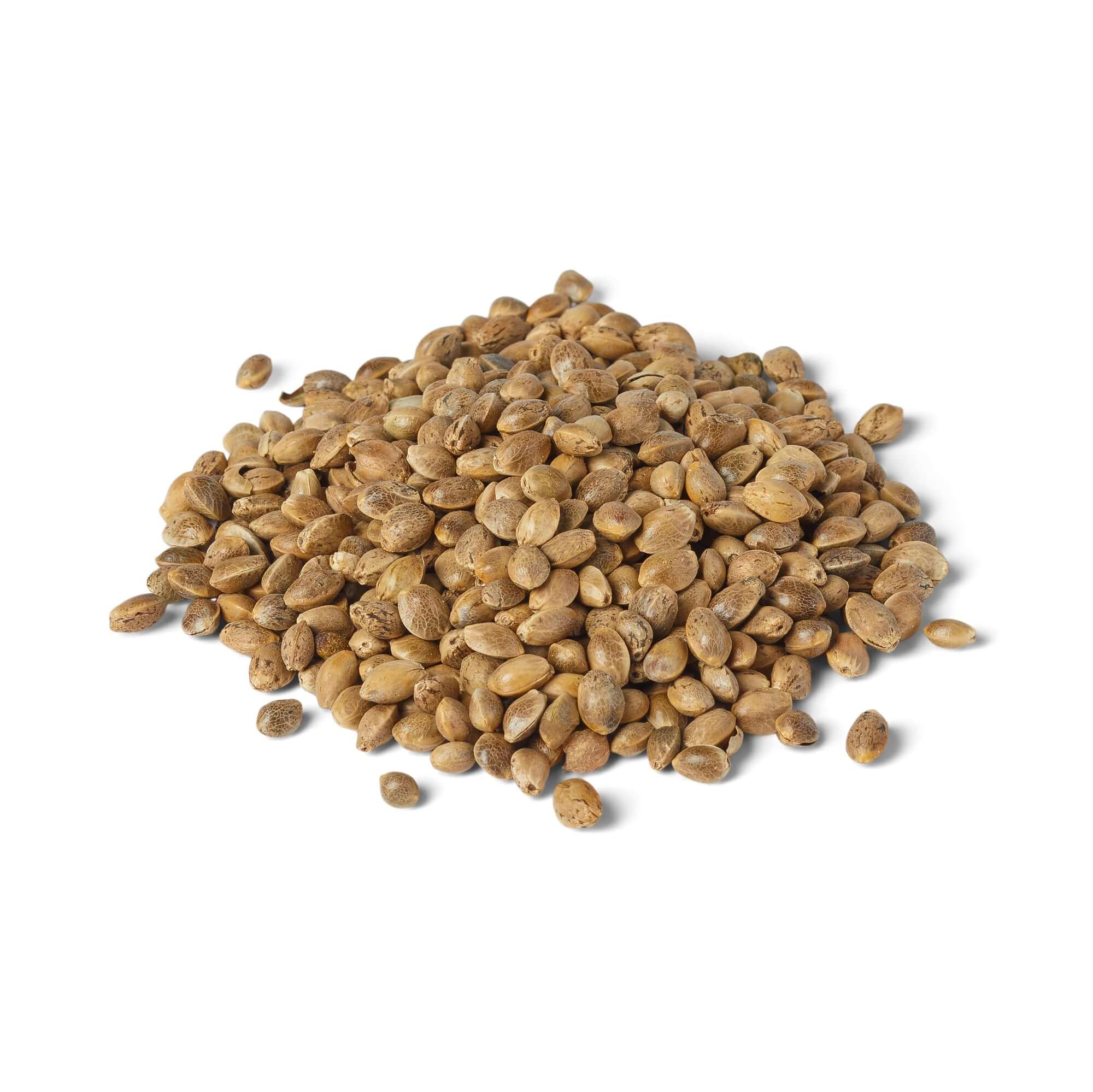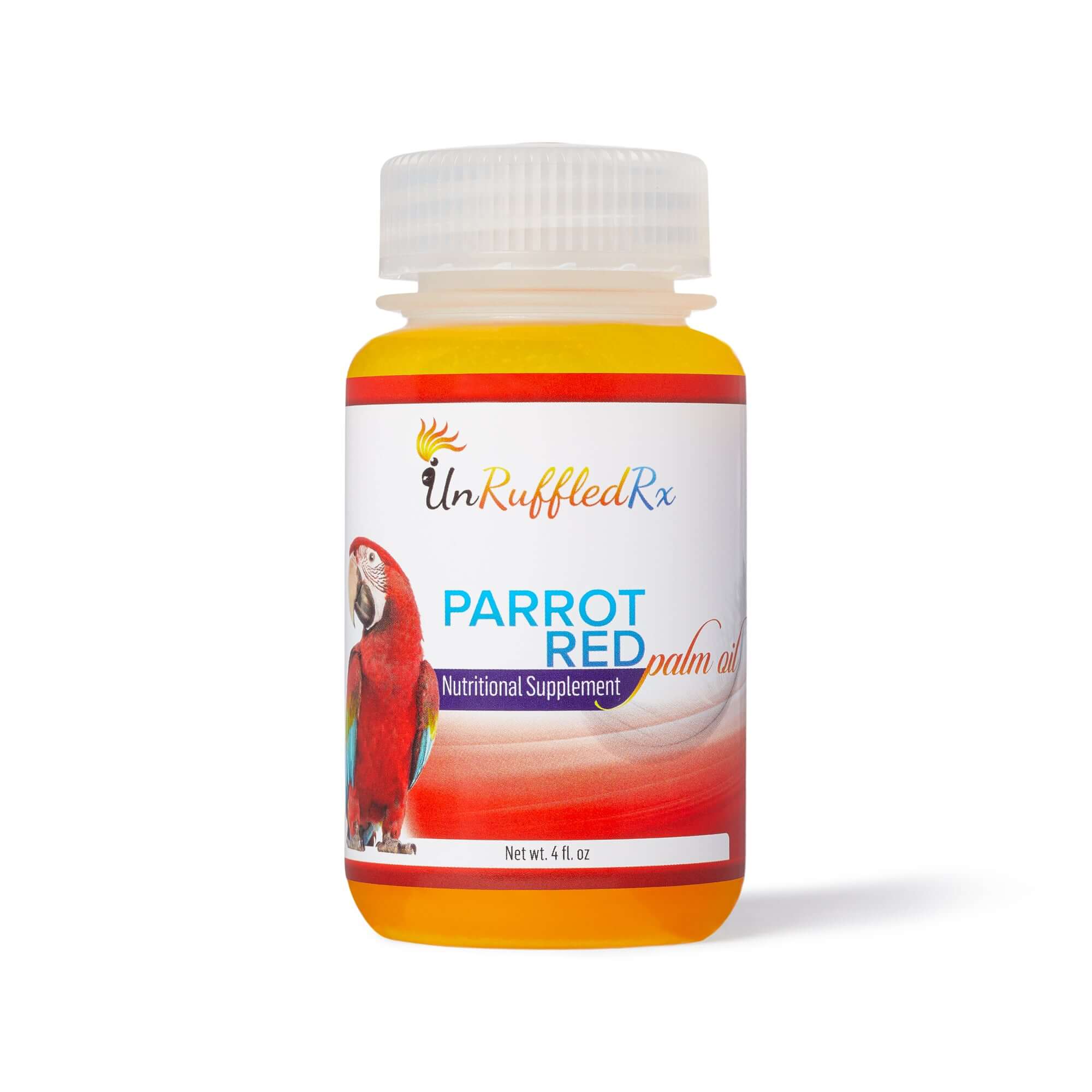GOOD PARROT CARE FOR FEATHER PLUCKING BIRDS
This parrot care article how to managing stress in feather plucking birds Discover common parrot care stressors that contribute to feather plucking in birds. A stressed-out bird is likely to have unwanted behavior due to mental and physical distress.
Stress plays a major role in the overall health of both people and companion parrots. Because parrots are naturally sensitive and exotic pets, they may have difficulties coping with the human lifestyle. Other types of pets, such as cats and dogs are domesticated, but parrots still have the rainforest running wild through their blood, That’s why we love them! Stress is a major contributing factor in feather plucking birds.
A parrots’ body is still adapted to the wild and to flight. Homelife can be very stressful for them unless you specifically make accommodations for the bird. Being able to recognize physical and emotional stress in your parrot is an important part of parrot care. It's a good idea for parrot owners to learn how to monitor their pets’ stress levels and make adjustments as necessary to keep the bird healthy and happy at all times.
What common stressors do we see in feather plucking birds
Like people, parrots may experience stress for a number of different reasons. Most parrot species are from humid, equatorial areas. It can be stressful for them if their diet, sleep habits, exercise, feather care or environmental needs are not properly met. When a parrots environment isn't adapted to take into account their highly adapted bodies, we see feather plucking in birds.
As prey animals, many parrots enjoy a level of predictability. Changes in the environment, whether moving to a new house, changes within the family or other pets, outside noise such as thunderstorms and wind, paint color, or a venue change may cause the birds stress.
One common form of environmental stress is living in too of a small cage. Not getting enough exercise, poor nutrition, inadequate sleep or not enough social interaction literally causes physical discomfort. When there's not enough room to spread the wings and exercise, a parrot may get cabin fever and feel physically uncomfortable, which leads them to release pent up energy with unwanted behavior. Obviously, as humans, it would also be uncomfortable if we were limited to a small space without enough room to move about.
Unchecked, environmental stress may escalate to other behavioral problems. such as aggression and feather plucking birds. A biting and plucked parrots can be at risk of losing its home. One causes of why many parrots end up being relinquished to bird sanctuaries because their caretakers simply didn’t know how important parrot care strategies.
Identifying and safely managing stress in parrots, whether you have a tiny budgie, a larger parrot or an aviary full of different birds, is incredibly important. There are several approaches you can recognize and control your parrot's stress levels.
Types of Stress: From a behavioral standpoint
The following types of stress can easily be addressed in your parrot care routine. For more information check out our Parrot Plucking Series.
Physical Needs
- Diet
- Exercise
- Sleep
Emotional Needs
- Social needs
- Hormone management
- Intellectual stimulation | Boredom
- Safety Needs
Indications that your parrot is experiencing stress
Parrot stress bars:
One important physical indicator that your parrot is stressed out is the visible appearance of stress lines or "stress bars" on their feathers. Stress lines are tiny lines running sideways through feathers, as shown in the featured image of this blog. Take a look at your parrot's feathers to see if it has an unusual amount of stress bars, as this is an indication that something may be wrong in its environment.
If stress bars are present it may be an indication that the bird had a poor diet, inadequate enrichment, improper sleep or an infection during the period of time that the feather was developing. These stressors result in the body temporarily taking care of other systems rather than putting energy into feather development. Stress bars are actually compromised sections in the feather that render the feather susceptible to breakage. Broken feathers are uncomfortable and one cause of feather plucking in birds.
Stress bars are similar to what the geologist discovers when they studied the layers of the earth. Every layer tells a story about the conditions at the time the layer was created. The geologist may say whether there was volcanic activity or flood depending on the analysis of each surface. Stress bars often paint a picture, although less accurate, of the well-being of your bird at the period the feathers are developing.
The bars may be either dark or light in color or depigmented and clear, but they are always a sign that something has been, and may still be, wrong in the bird's environment.
For baby parrots, feeding times that are too far apart, forceful in nature and served too hot or cold will contribute to stress bars. It's not unusual to find a few stress bars on baby parrots. However, stress bars in adult parrots should be taken very seriously.
Stress bars only occur during feather development following a molt. The molting process takes several weeks. You'll have to look back to your pets last molt to determine what could have caused it enough stress that it impaired feather growth. If you can't determine a stressful event and you note many damaged feathers, the culprit could be that your bird has been suffering from malnutrition or mental turmoil for some time.
In order to get to the root of the problem, you will need to thoroughly look into your parrot's environment and make appropriate changes. Assess your overall performance as a caregiver with sincerity and modesty. Inadequate diets are more often than not a large part of the problem.
If your pet has a lot of stress bars, you’d be wise to get a good physical exam to determine if bodily systems are involved. Your vet can also coach you on important parrot care strategies to reduce stress.
Molting and growing new feathers are quite stressful on your bird’s body. In the wild, a bird molts in early spring right before breeding season. During this time the bird's body is undergoing a lot of changes as it prepares for parenthood.
Feather growth and rearing young both require a large number of proteins, amino acids, and calcium. Vitamin A is essential for internal and external skin health. Spring-time brings about an abundance of new plant growth which is rich in feather growth nutrients. For beautiful plumage, you’ll want to address the rich nutritional parrot care needs during molt. One great source of feather growth nutrients is UnRuffledRx FeatheredUp!
COMMON BEHAVIOR ISSUES IN STRESSED OUT BIRDS
Aggression
If your parrot suddenly changes its demeanor and becomes aggressive, it could be a sign of stress or that it is experiencing a hormonal state or that something is stressing it out. Biting, hissing, lunging, and excessive screaming are all symptoms to look out for. Hormonal parrots naturally become more territorial, especially if they’ve been allowed to sexually bond with a perceived human mate. Learn about the strategies to reduce parrot hormonal behavior here. (link to hormonal blogs)
Fear
Not all parrots have bonded well with humans, especially those that have been re-homed or abused. If your parrot is unexpectedly nervous and hates being approached, it could be an indication that your feathered companion is stressed-out. A number of things, such as a new human being around more often, may give rise to anxiety. Identifying what causes the bird to become anxious is important. You may wish to do a time study to determine what triggers anxiety-related behaviors. That way, you can easily ward off unwanted behavior and increase your pet’s quality of life. You can learn more about how to conduct a time study here.
Physical Signs of Stress
Bird Weight Loss
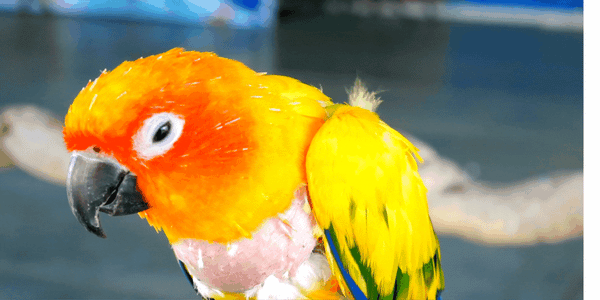
Sick and highly stressed birds may refuse to eat. For them, it is a defense mechanism. A stressed bird in the wild causes the whole flock to become prey. We strongly suggest that you closely monitor your pet birds’ weight on a weekly basis at the highly accurate gram level. I bought an accurate gram scale on Amazon for $13! Get your birds' average weight over the course of a few weeks. Record weight weekly, and should you notice a 5% weight loss, put on your detective hat to find out what the problem is. A 10% weight loss warrants a trip to the vet for a wellness check. It could be stress or it could be an illness in the early stages.
Feather Plucking Birds
Feather plucking in birds rarely has one cause. It's usually a combination of several things gone array. It could be a medical event, a one-time large stressor or ongoing stressful conditions. If your bird suddenly starts plucking, the first course of action is to rule out a medical cause. Next, examine the environment and your parrot husbandry practices to ensure that everything is optimized for your exotic pet. Then, think back in time and determine if a significant stressful event has occurred. Maybe a poor wing trim causes it to lose its balance or the loss of a loved one. If there is something that can be done to reduce or calm the stressful event take action. For instance, in the case of a bad wing trim, lower perches to make a painful fall less likely. Or, in the case of a lost love one, provide sensory stimulation such as playing wild parrot or aviary videos for your pet to help distract it from its emotional turmoil and simulate socialization.
Regardless of the cause, feather plucking in birds turns into an obsessive habit quickly. Develop your behavior modification skills to try to figure out what triggers the plucking to start and what your reaction is that the bird finds to be rewarding. You can find out more about behavior modification here.
Repetitive Behavior
Repetitive behaviors include pacing or swaying back and forth, toe-tapping, and head bobbing. Birds use repetitive behaviors for sensory stimulation when they become chronically bored. Some species are more prone to stereotypic behavior than others but know that stereotypic behaviors are often a psychological reaction to extreme boredom. This type of parrot stress can easily be corrected by offering your pet enrichment opportunities that promote curiosity, problem-solving, play, and exercise.
How good parrot care can reduce stress
Learn to read parrot body language
The most important thing you can do to help your bird calm down is to learn to read its body language and react to its moods and feelings accordingly. So, how are you going to learn" parrotese?" You can't read the mind of your parrots! The solution is to start teaching basic tricks to your parrot. Teach tricks such as shooting hoops or putting a coin in a piggy bank. When you teach your parrot, you learn to closely observe your parrot's body language. You get acquainted with how his feathers and posture change with different emotional states. You begin to notice when your bird is paying attention to you and how it communicates its wants and needs. Was it about to fly away from the perch? Is she getting bored? Does she need more encouragement? These are all the mental states of mind that you learn to read through trick training sessions. As your bird feels “heard,” it develops more trust with you and calms down. When you continue to respond appropriately to the bird's feelings, you can prevent anxious moments.
Once you know how to tell if your parrot is stressed out, you can improve parrot care strategies to enhance its quality of life. One strategy to help your very social pet is to learn to read parrot body language. It opens up a whole new level of communication with your bird. Your parrot should learn to recognize some of your body language, too. Keep in mind that your bird has the emotional development of about three-year-old child, so it's pretty self-centered. As such, the responsibility of interacting with your parrot is on you.
Parrots give warnings when they are stressed. A nervous parrot will enter a “fight or flight” state of mind faster than you can shake a stick. If you've got a stick, that's it! Nevertheless, a parrot that has been trained to trust you, through successful behavioral modification strategies, should naturally feel calmer. Think about how happy your parrot gets as she performs a basic trick, like "waving hello" and then gets the attention she needs from you (as well as a feeling of understanding of how to be an effective flock member in your home. Teaching simple to high-level tricks does wonders to support your birds’ self-confidence.
Picture how happy, secure and bonded your parrot feels when you're sharing whistles or singing to it. Even a quick game of tug of war with a bird-safe toy tells your parrot that you love it. Notice when your bird is trying to get your attention. For instance, my Timmy jiggles his food bowl at my house, when he’s hungry. Peachy, my cockatoo, hollers “Whatcha doin’?” in a voice that makes me smile and give him the attention that he wants. Then, Smokey and I have a peculiar whistle that we do to let each other know our whereabouts or that we’re thinking of each other. Once I understand their wishes and act accordingly, the trust grows and becomes mutual. They learn to trust me more, which leads to a calmer attitude.
Science tells us that all of us, both humans and animals, engage in a behavior because it serves a purpose. Whether we want to get something from someone else, be it praise or compensation, or we need to avoid something that causes uncomfortable feelings like fear, behavior serves a purpose. Fear is quite normal for prey animals. Stressed parrots may also engage in repetitive sensory stimulation.
Sure, you've got to learn to decipher parrot body language, but a good old "Behavior Time Study" will help you understand why and what is causing the nervous behavior that you're worried about. Some unwelcome behaviors may include nervous and undesirable conduct that, in parrot language, looks like violence (biting, screaming) or distress (hurting by feather plucking and self-mutilation). And, if your parrot drives you off with anger and screams or draws its’ concerns inside with feather plucking, a time study will help you learn what accommodations you need to make to prevent the unwanted behavior in the first place.
Encourage your parrot to be a parrot
Wild parrots get lots of physical exercise and socialization each day as they search or food sites and watering holes. This is how they interact in the forest. Such conduct is a matter of life and death of wild birds, and it is in the genetics of your exotic pets. Your pet parrot needs socialization, mental stimulation and exercise each day, as well.
Reward the behaviors that you enjoy
When you're trying to calm down your parrot, make it a special point to always generously reward your parrot’s play, exercise, and normal preening. Toss a favorite treat in its dish as a reward. Or, stop to talk to your parrot, whistle, and dance with it. Jingle a bell or play with it explicitly. A good head scritch will do the trick, too! Reward the parrot for normal parrot activities such as playing, singing, whistling, moving, doing a trick, and, of course, foraging!
Prevention is the best medicine
By now, you’ve realized that any kind of “training” is really well-spent one-on-one time with your pet. Highly social animals like parrots need your time just like a baby does. Socialization is important for a safe, balanced psyche. Training by rewarding desired behaviors is one strategy. Another bird training strategy is called Clicker Training, in which you train simple to advanced tricks, such as putting a coin in a piggy bank. Training for simple tricks such as waving hello or the eagle wing are super easy and fun. When training, you'll cue for the bird to do the behavior. Now, rather than reward your bird for an unwanted behavior, you can cue the bird to perform the trick and reward the trick.
Meet your parrots physical & emotional needs
As you're spending time training your parrot, why don't you teach her several behaviors that she can do on cue but that are inconsistent with acting up? For instance, have you noticed that a parrot can't scream and wave at the same time? Yes! It's a matter of fact. Your bird can’t pluck when its spreading eagle wing, a trick where your bird opens its wings on cue. You can cue an already learned behavior to interrupt problem behavior or just cue it to reduce boredom So, how about introducing a special whistle to your parrot? Then, before she starts screaming, cue the whistle. The more you get into the habit of offering your bird positive attention for doing the "tricks" you've trained, and stop paying attention to problem behavior, the faster the stress-related problem behavior will diminish..
Separate behavior from your pets worth
Proper parrot care starts with a change in your mindset. Your parrot is an exotic pet, and that said, try to separate its behavior from its innate worth. Exotic pets have simply not been domesticated as dogs and cats have been. If it is screaming, biting, or feather plucking keep in mind that it is just following its instincts and needs the training to learn your expectations. First of all, think about what may have caused the behavior. Behavior is always triggered by something and the bird gains something out of it. In other words, a behavior occurs because the bird gains something that is desired or escapes something that it wanted to avoid. Ask yourself, “What was my reaction immediately following the behavior that the bird found to be rewarding?” Now, you can guess what your bird really wants. If it plucks and you rush over to “have a chat” with it, the bird may have wanted attention. Instead, alter up the environment so that the behavior isn’t triggered in the first place, then alter up your reactions following the behavior so that the bird is not rewarded for “unwanted behavior.”. Then, consistently attend to the bird when it is behaving in a safe, fun manner. Praise the actions you want to see more of.
Healthy Diet
The best way to keep unwanted behavior at bay is to provide a healthy diet and to keep it busy throughout the day by offering fun foraging opportunities. Foraging is when an individual has to work for food. Foraging can encompass mentally figuring out how to get a morsel or having to physically work to get it Wild parrots fly miles to discover where food sources are, and then they have to think about how to get to meals. You should mimic these exercises to offer your pet the enrichment that it needs. A parrot that has the opportunity to engage in natural parrot behavior is naturally calmer and happier.
Why stop with planning an enriching meal? Put the fun in the toy box. Parrots like toys that they can chew, destroy and puzzles that they can problem-solve challenges. Set up an enrichment program to encourage yourself to change toys out on a regular basis. Re-use used items that are still in good shape or recycle bird toy parts.
Get out of the rut
Shuffle up your parrot care routine so that your parrot doesn’t get bored. Say your normal weekend routine is to get your parrot out of the cage at 9:00 a.m. Guess who starts screaming at 8:45 a.m.? Instead of rewarding rambunctious conduct, changing the times that you awaken the bird? How about letting the bird out when it's quiet? Better yet, kick your routine up a notch. Cook up a batch of nutrient-rich veggies, grains, and herbs to reward fun-to-be-around behavior.
All of these suggestions will help your parrot feel nutritionally healthy, physically fit, more enriched, and, thereby calmer. And, the bonus for you is that you’ll want to get your calmer pet out of the cage so that it can be part of the household flock. Hey! That’s why you got such a social and engaging pet in the first place. Right!
Conclusion
Feather plucking in birds is very stressful for the human caretaker and the bird alike. Parrots are one of the smartest birds around. Plus, they are flock animals who need significant socialization and mental stimulation. Their intellect, ability to talk and goofy antics make them fun and delightful pets to be around. But, their sensitivity and special care needs can result in feather plucking birds.
Below are essential parrot care tips that will ensure your new parrot will be happy and healthy. So, let’s revisit what we just covered.
- Do your homework and learn about parrot care before a problem arises.
- Give your pet as large of a cage (with proper bar space, please) that you can afford so that the bird gets plenty of exercise and opportunities for enrichment.
- Create a flexible parrot care routine while offering up just enough unpredictability to make things exciting.
- Learn the basics of “behavior management.” Ensure wellness and reward only the behaviors that you want to see more of.
- Your bird is what it eats. If you think that you’re pampering it with lots of sweet fruits, fatty nuts, and seeds that are fun to crack open, think again. Parrots have strict nutritional needs that are best met with premium, organic pellets and a dollop of nutrient-rich grains, leafy greens, and colorful vegetables.
- Keep in mind that an ounce of prevention is worth a pound of cure. Get routine physical exams to catch problems early. And, at first glance that behavior is going array, consult with an avian behavior expert. Not just a self-proclaimed internet guru, but an educated, licensed or certified expert who really knows their stuff. Avian vets support physical needs while avian behaviorists support parrot mental health and behavioral issues.

